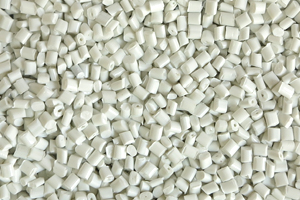Polyethylene (PET)

Polyethylene terephthalate (PET or PETE), a strong, stiff synthetic fibre and resin, and a member of the polyester family of polymers. PET is spun into fibres for permanent-press fabrics, blow-molded into disposable beverage bottles, and extruded into photographic film and magnetic recording tape.
PET is produced by the polymerization of ethylene glycol and terephthalic acid. Ethylene glycol is a colourless liquid obtained from ethylene, and terephthalic acid is a crystalline solid obtained from xylene. When heated together under the influence of chemical catalysts, ethylene glycol and terephthalic acid produce PET in the form of a molten, viscous mass that can be spun directly to fibres or solidified for later processing as a plastic. In chemical terms, ethylene glycol is a diol, an alcohol with a molecular structure that contains two hydroxyl (OH) groups, and terephthalic acid is a dicarboxylic aromatic acid, an acid with a molecular structure that contains a large, six-sided carbon (or aromatic) ring and two carboxyl (CO2H) groups. Under the influence of heat and catalysts, the hydroxyl and carboxyl groups react to form ester (CO-O) groups, which serve as the chemical links joining multiple PET units together into long-chain polymers. Water is also produced as a by-product. The overall reaction can be represented as follows:
The presence of a large aromatic ring in the PET repeating units gives the polymer notable stiffness and strength, especially when the polymer chains are aligned with one another in an orderly arrangement by drawing (stretching).
PET is also made into fibre filling for insulated clothing and for furniture and pillows. When made in very fine filaments, it is used in artificial silk, and in large-diameter filaments it is used in carpets. Among the industrial applications of PET are automobile tire yarns, conveyor belts and drive belts, reinforcement for fire and garden hoses, seat belts (an application in which it has largely replaced nylon), nonwoven fabrics for stabilizing drainage ditches, culverts, and railroad beds, and nonwovens for use as diaper topsheets and disposable medical garments. PET is the most important of the man-made fibres in weight produced and in value.
At a slightly higher molecular weight, PET is made into a high-strength plastic that can be shaped by all the common methods employed with other thermoplastics. Magnetic recording tape and photographic film are produced by extrusion of PET film (often sold under the trademarks Mylar and Melinex). Molten PET can be blow-molded into transparent containers of high strength and rigidity that are also virtually impermeable to gas and liquid. In this form, PET has become widely used in carbonated-beverage bottles and in jars for food processed at low temperatures. The low softening temperature of PET—approximately 70 °C (160 °F) prevents it from being used as a container for hot-filled foods.
PET is the most widely recycled plastic. PET bottles and containers are commonly melted down and spun into fibres for fibrefill or carpets. When collected in a suitably pure state, PET can be recycled into its original uses, and methods have been devised for breaking the polymer down into its chemical precursors for resynthesizing into PET.